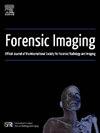在死后CT扫描中意外发现金属异物:子弹还是不是子弹?
IF 1
Q4 RADIOLOGY, NUCLEAR MEDICINE & MEDICAL IMAGING
引用次数: 0
摘要
在不断扩大的尸体成像领域,尸体计算机断层扫描(PMCT)已经成为法医病理学家的重要工具。它对于检测和准确定位金属异物特别有价值,从而协助法医病理学家进行尸检。本研究提出了一个在PMCT中意外发现异物的案例,由于其金属外观和受害者参与武装冲突的历史,法医病理学家在尸检前迅速审查了扫描结果,最初将其误认为是潜在的弹道异物。法医病理学家不知道微型起搏器,特别是经导管起搏系统(TPS),最初怀疑是心脏子弹,但在尸检中排除了这种可能性,因为没有外伤或皮肤进入伤口的迹象,也没有发现TPS。先进的处理技术可以识别出TPS的特征锚定时间,确认其性质并将其与子弹区分开来。这突出了精确的尸检图像解释的重要性。本文章由计算机程序翻译,如有差异,请以英文原文为准。

Fortuitous discovery of a metallic foreign body on post-mortem CT scan: bullet or not bullet?
In the expanding field of post-mortem imaging, post-mortem computed tomography (PMCT) has emerged as an essential tool for forensic pathologists. It is particularly valuable for detecting and accurately localizing metallic foreign bodies, thereby assisting the forensic pathologist during the autopsy. This study presents a case of an accidental finding of a foreign body during a PMCT, initially misinterpreted as a potential ballistic foreign body by the forensic pathologist who had quickly reviewed the scan prior to the autopsy, due to its metallic appearance and the victim’s history of involvement in armed conflicts. The forensic pathologist, unaware of a miniaturized pacemaker, specifically a Transcatheter Pacing System (TPS), initially suspected a cardiac bullet but ruled this out upon autopsy, as there were no signs of trauma or cutaneous entry wounds and the discovery of the TPS. Advanced processing techniques allowed the identification of the characteristic anchoring tines of the TPS, confirming its nature and distinguishing it from a bullet. This highlights the importance of precise post-mortem images’ interpretation.
求助全文
通过发布文献求助,成功后即可免费获取论文全文。
去求助
来源期刊

Forensic Imaging
RADIOLOGY, NUCLEAR MEDICINE & MEDICAL IMAGING-
CiteScore
2.20
自引率
27.30%
发文量
39
 求助内容:
求助内容: 应助结果提醒方式:
应助结果提醒方式:


